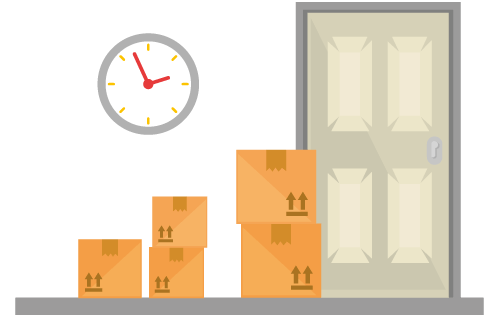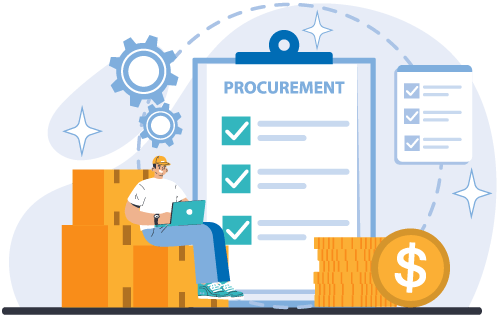Have You Taken a Look at Your Order Fulfillment Rates Recently?
Built For


Have You Taken a Look at Your Order Fulfillment Rates Recently?
Have you checked in on your order fulfillment rates lately? If not, it might be time for a closer look. Order fulfillment rates are more than just numbers—they can tell you a lot about the health of your business and how satisfied your customers are with your service. After all, fast and accurate deliveries are crucial for keeping customers happy, and if your fulfillment rates are slipping, it could be a sign that something in your process needs attention.
Understanding Order Fulfillment Rates
Before you can improve your order fulfillment process, it’s essential to understand what your fulfillment rate is and how to measure it. Simply put, your order fulfillment rate is a key performance indicator (KPI) that shows the percentage of orders you fulfill on time. It’s a direct reflection of how efficiently your business is delivering on customer expectations.
To calculate it, use this formula:
Order Fulfillment Rate = (Total Orders Delivered on Time / Total Orders) x 100
For example, if you shipped 950 orders on time out of 1,000 total orders in a given period, your fulfillment rate would be 95%. This percentage is a powerful metric—it shows how well you’re doing in terms of getting products to your customers when they expect them.
Why Order Fulfillment Rates Matter
A high order fulfillment rate indicates that your processes—from inventory management to shipping—are running smoothly. On the other hand, a low rate can signal problems like stockouts, order processing delays, or issues with your shipping carriers. These hiccups not only cost you time and money but can also lead to unhappy customers and even lost business.
What’s a Good Fulfillment Rate?
While every industry differs, a general benchmark for a “good” fulfillment rate is around 98% or higher. That may sound steep, but with the right tools and strategies in place, it’s an achievable goal. Remember that today’s customers expect fast and accurate deliveries, so even a slight dip in your fulfillment rate could have a noticeable impact on customer satisfaction.
Factors That Affect Order Fulfillment Rates

Several elements can impact your order fulfillment rates; understanding them is the first step to improvement. Let’s take a closer look at some of the most common factors that could be holding you back:
Inventory Accuracy and Stockouts
When your inventory isn’t accurately tracked, you risk selling products that aren’t in stock, leading to delays and backorders. Stockouts can seriously hurt your fulfillment rate, as you can’t ship orders on time if you don’t have the items available. Ensuring accurate inventory counts and real-time inventory tracking can help you avoid this issue.
Order Processing Efficiency
How quickly and accurately orders are processed can make or break your fulfillment rate. A streamlined order processing system ensures that orders move smoothly from the sales channel to the warehouse. If your process is bogged down with manual tasks or inefficient workflows, it can cause delays and errors, slowing down the fulfillment process.
Shipping Delays and Logistics Challenges
Once the order is packed and ready to go, the next challenge is ensuring timely shipping. Shipping delays—whether due to carrier issues, unexpected demand spikes, or poor coordination—can severely impact your fulfillment rates. Keeping an eye on shipping performance and having contingency plans for disruptions can help keep things on track.
Supplier Reliability and Lead Times
Your suppliers play a significant role in your ability to fulfill orders on time. If your lead times are long or unpredictable, you might not receive products in time to meet customer demand. Building strong relationships with reliable suppliers and managing lead times effectively can help prevent delays in replenishing stock.
By addressing these factors head-on, you’ll be in a much better position to improve your fulfillment rates and keep your customers happy.
Strategies for Boosting Fulfillment Rates

Improving your order fulfillment rates doesn’t have to be complicated. By implementing a few key strategies, operations can be streamlined and you can see significant improvements in how quickly and accurately you fulfill orders.
Forecast Demand to Avoid Stockouts and Overstocking
One of the easiest ways to boost fulfillment rates is to ensure you always have the right inventory. Forecasting demand using historical sales data and seasonal trends can help you maintain optimal stock levels. This way, you can prevent stockouts that delay orders and avoid overstocking, which ties up resources unnecessarily.
Enhance Warehouse Efficiency
The layout and organization of your warehouse play a massive role in how fast your team can pick, pack, and ship orders. Optimize your warehouse by placing popular items closer to packing stations and organizing products to reduce the time and distance it takes to retrieve them. Additionally, you can improve picking efficiency by using tools like mobile barcode scanners or implementing a batch-picking strategy to handle multiple orders simultaneously.
Real-Time Inventory Updates
Real-time visibility into your inventory levels ensures you’re never caught off guard by a stockout or overselling. When all your sales channels, warehouses, and teams can access accurate, up-to-date inventory data, you can make informed decisions and fulfill orders faster.
Regular Staff Training on Fulfillment Processes
Your team plays a vital role in the fulfillment process, and ensuring they’re well-trained can lead to significant improvements. Regular training sessions on picking, packing, and shipping best practices can help employees work more efficiently and with fewer errors. Process consistency leads to fewer delays and improved accuracy, both of which directly boost fulfillment rates.
Use Technology to Streamline Fulfillment
Technology can drastically improve your fulfillment process.
- Inventory and order management software automates the process, from receiving orders to updating stock levels to generating shipping labels.
- Barcoding technology also speeds up picking and packing while reducing the chances of errors.
- EDI (Electronic Data Interchange) automates transactions and integrates with your systems for seamless order processing.
By implementing these strategies, you’ll be well on your way to improving your order fulfillment rates and ensuring customers receive orders on time and without issues.
How to Monitor and Analyze Fulfillment Rates

Monitoring your order fulfillment rates is vital to understanding how well your business meets customer expectations and identifying areas for improvement. Fortunately, with the right tools and key metrics, you can closely monitor your fulfillment performance and make data-driven decisions.
Track Key Performance Indicators (KPIs)
There are a few essential KPIs you should track regularly to get a clear picture of your order fulfillment performance:
- Lead Time: This is the time it takes to replenish stock after placing an order with a supplier. Long lead times can affect your ability to fulfill future orders.
- On-Time Delivery Rate measures the percentage of orders delivered on time. It’s one of the most critical KPIs for understanding how well your fulfillment process is working.
- Order Accuracy Rate tracks how often orders are fulfilled correctly without mistakes, such as sending the wrong item or quantity.
- Cycle Time: This refers to the amount of time it takes to fulfill an order, from the moment it’s placed to the moment it’s delivered.
Leverage Inventory Management Dashboards
Inventory and order management software includes customizable dashboards that provide real-time data on fulfillment operations. These dashboards allow you to monitor KPIs at a glance, identify bottlenecks in your process, and get alerts when something goes off track. Real-time data is essential for making adjustments to improve your fulfillment rates.
Use Real-Time Reporting for Deeper Insights
Real-time reporting is a powerful tool for analyzing your fulfillment rates more thoroughly. Pulling reports on order fulfillment trends over time allows you to identify patterns, such as seasonal slowdowns or common issues that delay shipments. Real-time reporting enables you to proactively address potential problems before they impact your customers.
Regularly Review Performance and Set Benchmarks
To continuously improve, you must set benchmarks for your fulfillment KPIs and regularly review performance against them. For example, if your current on-time delivery rate is 90%, set a goal to increase it to 95% over the next quarter. Regularly reviewing your fulfillment data allows you to track progress and implement necessary changes to reach those goals.
By monitoring these metrics closely and using the tools available, you can ensure that your fulfillment rates stay high and that your operations run efficiently.
Best Practices for Continuous Improvement

Maintaining high order fulfillment rates is an ongoing process. It’s important to consistently evaluate and fine-tune your operations to keep improving. Here are some best practices to help ensure continuous improvement in your fulfillment process:
Regularly Review Fulfillment Performance
Make it a habit to routinely analyze your order fulfillment data. By reviewing KPIs like on-time delivery, cycle time, and order accuracy regularly, you can identify areas for improvement. Set aside time for monthly or quarterly performance reviews to ensure you’re staying on track with your fulfillment goals.
Gather Customer Feedback
Your customers’ experiences with your fulfillment process are invaluable. Are they receiving their orders on time? Was the order accurate? Collecting and analyzing customer feedback can provide insight into any pain points they experience and help you identify opportunities for improvement. Consider sending out post-purchase surveys or monitoring customer reviews for this purpose.
Make Data-Driven Adjustments
Leverage the data you gather from your inventory and order management system to make intelligent, informed decisions. If you notice consistent bottlenecks or delays, use the data to determine exactly where things go wrong. For example, if orders are consistently delayed in the picking stage, you might consider reorganizing your warehouse or investing in more efficient picking technology.
Optimize Your Supply Chain
An efficient supply chain is crucial to high fulfillment rates. Continuously evaluate your relationships with suppliers and shipping partners. Are your suppliers consistently meeting lead times? Are there any recurring issues with shipping delays? Strengthening your supply chain and building strong relationships with reliable partners will help keep your fulfillment process running smoothly.
Invest in Employee Training
The human element plays a large role in fulfillment success. Regularly train your staff on updated processes, new technology, and best practices for efficiency and accuracy. Well-trained employees follow procedures correctly, leading to fewer errors and faster order fulfillment.
Embrace Automation Where Possible
Automation can take your fulfillment process to the next level. Automating critical tasks like order processing, inventory updates, and shipping label creation can reduce manual errors and speed up fulfillment. Inventory management software, barcoding systems, and EDI (Electronic Data Interchange) are valuable tools that can help you automate repetitive tasks.
Adopt these best practices, continuously seek ways to keep your fulfillment rates high and your customers satisfied, and create an efficient, reliable, and adaptable fulfillment process for your business’s changing needs.
Call us at 817-870-1311





